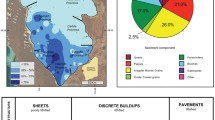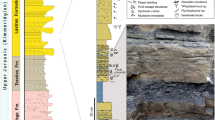Abstract
THE Worm's Head, part of the Nature Conservancy Gower Coast National Nature Reserve, lies at the south-western tip of the Gower Peninsula of Glamorganshire, South Wales. It is a Carboniferous limestone headland accessible only at low tide across a wave-cut limestone platform. On the southern side of the Inner Head (Ord. Surv. Grid Ref. SS 395873) is a section in Pleistocene deposits of a type recorded widely in Gower1–3, and elsewhere in southern Britain. This can be summarized from the base upwards as follows : (1) Wave-cut limestone platform; (2) raised beach of calcite-cemented limestone pebbles banked against solid limestone; the Patella beach; (3) remnants of bright red sandy clay loam, 10–18 in. thick, containing rare limestone pebbles with red weathered outer zones; (4) brown loam containing abundant angular limestone, a periglacial head deposit. The thickness of this is variable from 0 to 10 ft.; (5) dull grey-brown stony sandy loam, glacial drift containing abundant Old Red Sandstone and Carboniferous grits and sandstones; where this is preserved on the flanks of the Worm's Head, the depth averages 4–6 ft.; (6) dull, grey-brown, sandy loam, almost stoneless, similar to the matrix of horizon 5, resting variously on horizons 2, 3 or 6.
This is a preview of subscription content, access via your institution
Access options
Subscribe to this journal
Receive 51 print issues and online access
$199.00 per year
only $3.90 per issue
Buy this article
- Purchase on Springer Link
- Instant access to full article PDF
Prices may be subject to local taxes which are calculated during checkout
Similar content being viewed by others
References
Strahan, A., “The Geology of the South Wales Coalfield”. Pt. 9 (H.M.S.O., 1907).
George, T. N., Proc. Geol. Assoc., 43, 4, 291 (1932).
George, T. N., Geol. Mag., 70, 208 (1933).
Brewer, R., and Haldane, A. D., Soil Sci., 84, 301 (1957).
Osmond, D. A., and Stephen, I., J. Soil Sci., 8, 1, 19 (1957).
Dalrymple, J. B., J. Soil Sci., 9, 2, 199 (1958).
Stephen, I., Science Prog., 48, 322 (1960).
Kubiena, W. L., “The Soils of Europe” (Murby, 1953).
Kubiena, W. L., Proc. Sixth Int. Congr. Soil Sci., E, 247 (1956).
Author information
Authors and Affiliations
Rights and permissions
About this article
Cite this article
BALL, D. Relic-Soil on Limestone in South Wales. Nature 187, 497–498 (1960). https://doi.org/10.1038/187497b0
Issue Date:
DOI: https://doi.org/10.1038/187497b0
This article is cited by
-
Amino acid evidence for Devensian ice, west Gower, South Wales
Nature (1982)
-
Dating Pleistocene Events in South-west Wales
Nature (1966)
Comments
By submitting a comment you agree to abide by our Terms and Community Guidelines. If you find something abusive or that does not comply with our terms or guidelines please flag it as inappropriate.



